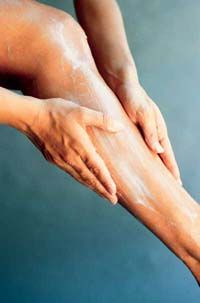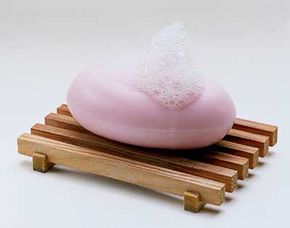Atopic dermatitis takes its name from "atopy," an inherited condition in which a person is predisposed to developing multiple allergic disorders, including asthma, hay fever, and food allergies. If you or a family member has an allergic disorder, you are at increased risk of developing atopic dermatitis.
Although atopic dermatitis is associated with allergic disorders, it is not itself an allergic reaction to a specific substance, as allergic contact dermatitis is. Rather, atopic dermatitis is a chronic and intensely itchy inflammation of the outer layer of skin. Its cause is unknown, although it appears to be related to an overly sensitive or malfunctioning immune system, and it can be aggravated by a variety of factors, such as temperature changes, skin infections, irritation from clothes or chemicals, and emotional stress.
Atopic dermatitis most frequently develops in children younger than five years old, and the majority of cases resolve by adulthood. However, the condition can first appear in adulthood or continue into adulthood after developing in childhood.
The main symptom of atopic dermatitis is an intensely itchy skin rash, although the itchiness may actually precede the appearance of the rash. In infants, the rash may first appear in patches on the cheeks and chin, although it may also occur on the scalp, diaper area, and extremities and eventually cover large areas of the body. In older children and adults, the rash tends to appear in fewer and more limited areas, such as around the mouth and in skin folds, especially at the crook of the elbow and the back of the knee.
The rash may appear dry and flaky at first, but the incredible itching often prompts scratching that further inflames the skin, increases itching, and can lead to blistering and crusting or cracking and secondary infection; some areas of skin may eventually become thick and leathery as a result. The skin of someone who has had atopic dermatitis tends to lose moisture and dry out easily and is more vulnerable to irritant contact dermatitis.
Beyond easing the itching, coping with this condition requires protecting the skin from additional irritation. The following home remedies may help:
Wash new clothes before wearing. This helps remove formaldehyde and other potentially irritating chemicals used to treat fabrics.
Rinse twice. Even if you use a mild laundry detergent, it's a good idea to rinse your clothes twice to make sure all of the soap is removed.
Wear loose, natural-fabric clothing. You want your skin to be able to "breathe," so choose loose-fitting, open-weave, cotton or cotton-blend clothes.
Keep temperatures constant. Abrupt temperature changes (hot to cold or vice versa) can irritate the skin, so try to avoid them whenever possible. Try to maintain constant humidity levels in your home, too.
Keep your fingernails trimmed. It's hard to scratch effectively, and therefore hard to cause further damage to your sensitive skin, if your fingernails are short.
Hydrate your skin with a bath or shower. Use warm, not hot, water, and soak or shower for at least 15 or 20 minutes. Avoid using a washcloth because it's abrasive.
Use soap only where necessary. Choose a gentle soap, such as Dove, Oiltum, Alpha Keri, Neutrogena, Purpose, or Basis; a nonsoap cleanser, such as Aveeno or Emulave; or a liquid cleaner, such as Moisturel, Neutrogena, or Dove. Rinse thoroughly, gently pat away excess moisture, and then apply moisturizer to your damp skin to seal in the water. Plain petroleum jelly is the best after-bath sealant.
Use moisturizer throughout the day. It's extremely important for people with atopic dermatitis to keep their skin from becoming too dry. Some good moisturizers include Aquaphor ointment, Eucerin cream, Moisturel cream or lotion, D.M.L. cream or lotion, Lubriderm cream or lotion, Neutrogena emulsion, Eutra, Vaseline dermatology lotion, or LactiCare lotion.
Use a sunscreen with an SPF of 15 or higher. A sunburn is only going to irritate the skin further.
Wash after swimming. The chlorine and other chemicals in most swimming pools can irritate sensitive skin. So shortly after you've finished your swim, take a shower or bath and use a mild soap all over. Don't forget to reapply your moisturizer, as well.
Check out your diet. Some physicians believe food allergies may play a role in atopic dermatitis, especially in childhood, while others say it hasn't been proven. If you suspect a particular food aggravates your rash, omit it from your diet for a few weeks. If the rash clears up but then returns when you reintroduce the food in your diet, consider permanently avoiding the food. Do not eliminate a large number of foods or an entire food group, however, without consulting your doctor first. If your child has atopic dermatitis and you suspect a food-allergy link, work with the child's pediatrician to investigate this possibility.
Sometimes adding certain foods to your diet can help ease dermatitis. In the next section, we will discuss how home remedies like nutritional therapy, herbal medicine, and other alternative treatments can help relieve itching and other symptoms.
For more information about dermatitis and how to combat it, try the following links:
This information is solely for informational purposes. IT IS NOT INTENDED TO PROVIDE MEDICAL ADVICE. Neither the Editors of Consumer Guide (R), Publications International, Ltd., the author nor publisher take responsibility for any possible consequences from any treatment, procedure, exercise, dietary modification, action or application of medication which results from reading or following the information contained in this information. The publication of this information does not constitute the practice of medicine, and this information does not replace the advice of your physician or other health care provider. Before undertaking any course of treatment, the reader must seek the advice of their physician or other health care provider.



